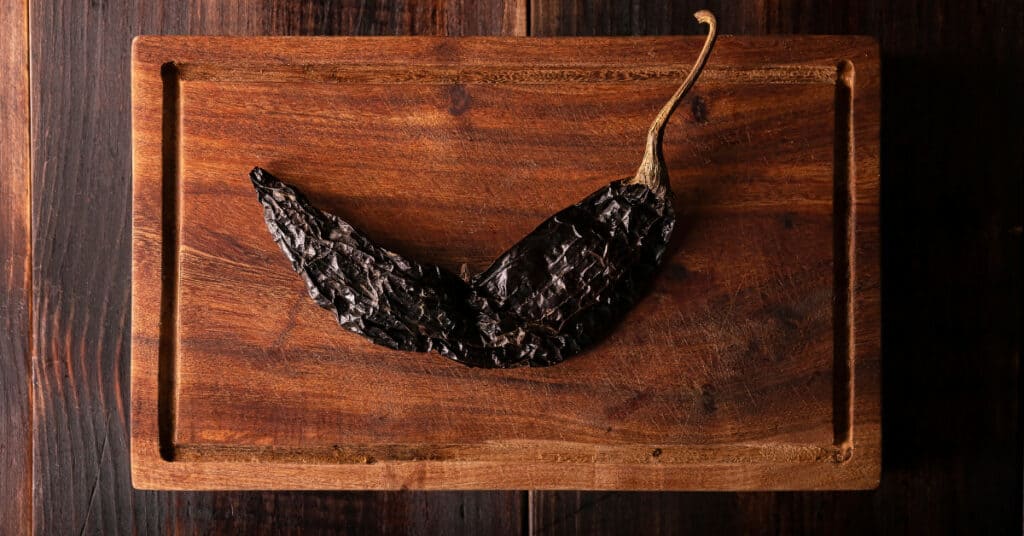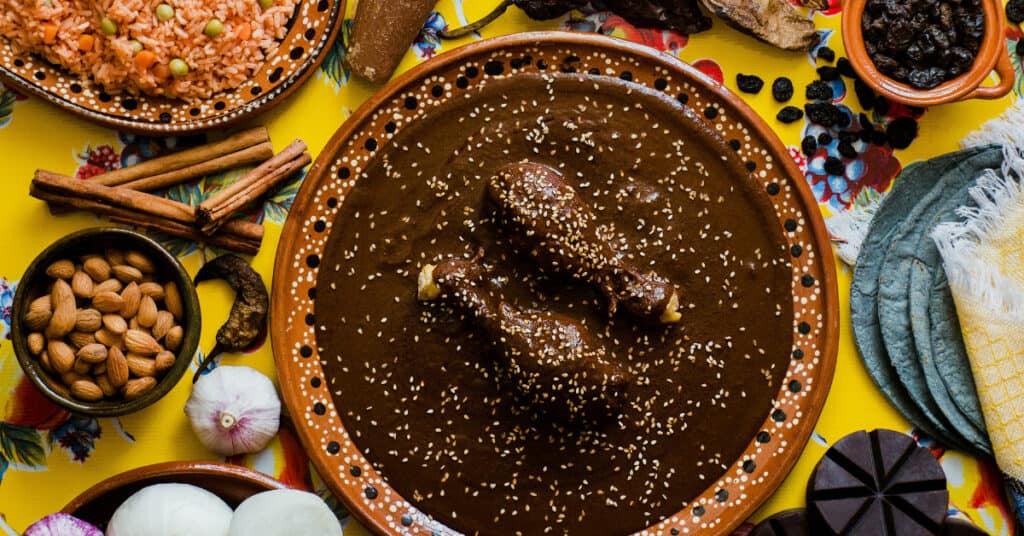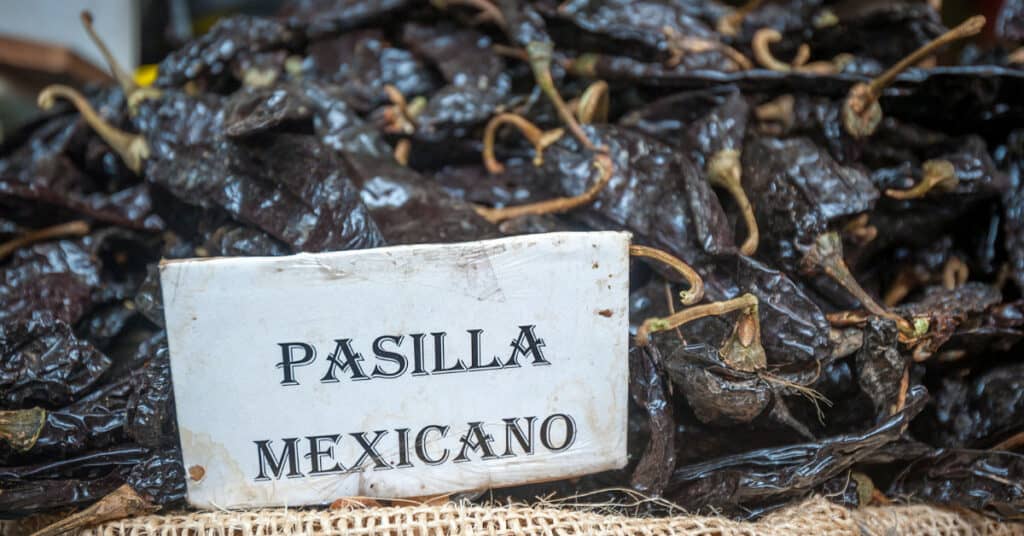SUMMARY: Pasilla peppers and Poblano peppers are popular chili peppers used in Mexican cuisine. While they may seem similar, the two have a few key differences. Pasilla peppers are a dried chile with a more complex smoky taste with a higher heat level, while Poblano peppers are milder with a earthy flavor. Understanding these distinctions will help you choose the right pepper for your recipes.
Do you need clarification about the difference between pasilla and poblano peppers?
If so, you’ve come to the right place. Let’s delve into these two popular peppers and discover their unique qualities and how to use them in your culinary adventures.
In this article, we will explore:
- The distinct characteristics of pasilla and poblano peppers
- How pasilla and poblano peppers can be used in various dishes
- The similarities and differences between these two peppers
- Frequently asked questions about pasilla and poblano peppers
Stay tuned as we unravel the secrets of pasilla and poblano peppers and empower you to elevate your cooking skills using these flavorful ingredients.
The Pasilla Pepper
Considered one of the key ingredients in Mexican cuisine, the pasilla pepper offers a unique flavor and depth to dishes. Here’s everything you need to know about this popular pepper:

Flavor Profile
- The pasilla pepper has a rich, earthy flavor with hints of raisins, berries, and chocolate.
- It brings a mild to medium heat level, making it suitable for those who prefer a bit of spice without overwhelming heat.
Usage
- Pasilla peppers are commonly used in traditional Mexican sauces such as mole and enchilada sauce.
- They add complexity to stews, soups, and salsas, lending the dish a smoky and fruity note.
- Roasting or toasting pasilla peppers intensifies their flavor and enhances their aroma.
Popular Dishes
- Chiles en Nogada: This iconic Mexican dish features roasted pasilla peppers stuffed with savory meat and fruit filling and a creamy walnut sauce.
- Pasilla Pepper Salsa: A versatile salsa made with roasted pasilla peppers, tomatoes, onions, and seasonings. It complements a wide range of dishes, from tacos to grilled meats.

Whether you’re a fan of Mexican cuisine or simply looking to experiment with new flavors, the pasilla pepper is a fantastic addition to your spice collection. Its distinctive taste and heat level make it a favorite among chili enthusiasts.
The Poblano Pepper
The poblano pepper, also known as Capsicum annuum, is a mild chili pepper from the Puebla region of Mexico. It is one of the most widely used peppers in Mexican cuisine. It plays a significant role in various traditional dishes. Here’s a closer look at the characteristics of the poblano pepper:

Flavor Profile and Heat Level
- The poblano pepper offers mild to medium heat, typically ranging from 1,000 to 2,000 Scoville heat units (SHU). While it does carry some level of spiciness, it is generally milder compared to other chili peppers.
- Poblanos are known for their rich, earthy, and slightly sweet flavor profile. The pepper’s taste is mildly smoky and reminiscent of fresh herbs.
- When roasted, the poblano develops a deeper, more complex flavor with hints of sweetness and spiciness.
Popular Dishes Featuring Poblano Peppers
Poblano peppers are a staple ingredient in numerous Mexican recipes. Here are some popular dishes where the poblano pepper plays a starring role:
- Chiles Rellenos: Poblano peppers are stuffed with cheese, meat, or a combination of both, then battered and deep-fried until golden. This dish showcases the pepper’s mild heat and enhances its flavor with a crispy exterior.
- Raja’s con Crema: Poblano peppers are charred, peeled, cut into strips, sautéed with onions, and simmered in a creamy sauce. This dish balances the mild heat of poblanos with the smoothness of the cream sauce.
- Mole Poblano: The famous mole sauce from Puebla features the poblano pepper as one of its key ingredients. The sauce combines flavorful ingredients such as chocolate, spices, nuts, and dried fruit.
- Poblano Rice: Poblano peppers are roasted, peeled, seeded, and then incorporated into rice for a fragrant and mildly spicy side dish.

The poblano pepper adds depth and complexity to dishes with its mild heat and distinctive flavor profile. Its versatility allows it to shine in both savory and sweet culinary creations.
Similarities
When it comes to pasilla and poblano peppers, several similarities make them somewhat interchangeable in certain recipes. Here are the key similarities to consider:
- Mild to Medium Heat: Both pasilla and poblano peppers offer a mild to medium level of spiciness, making them accessible to individuals who prefer less heat in their dishes.
- Rich Flavors: Both peppers boast unique and robust flavor profiles that enhance the taste of various dishes.
- Versatile Usage: Pasilla and poblano peppers can be used in many recipes, including soups, stews, sauces, salsas, and more.
- Roasting Potential: Both peppers are often roasted to bring out their distinct flavors and impart a smoky element to dishes.
- Mexican Cuisine: Pasilla and poblano peppers are widely used in Mexican cuisine, adding authenticity and depth to traditional dishes.
Differences
While pasilla and poblano peppers have some similarities, distinct characteristics set them apart. Understanding these differences can help you choose the pepper for your culinary needs. Here are the main variations between pasilla and poblano peppers:
Pasilla Pepper
- Long and Narrow Shape: Pasilla peppers are long and slender, typically measuring 6 to 10 inches long. They have a slightly wrinkled appearance and can range in color from dark redish-brown to almost black.
- Heat Level: Pasilla peppers are generally mild, with a heat level that ranges from 1,000 to 3,000 Scoville heat units (SHU). While they provide some spiciness, it is usually milder than other chili peppers.
- Flavor Profile: Pasilla peppers offer a unique, earthy flavor with hints of dried fruit, raisins, and chocolate. They have a distinctive smokiness that intensifies when the peppers are toasted or roasted.
- Usage: Pasilla peppers are commonly used in Mexican cuisine, especially in sauces, marinades, and moles.
Poblano Pepper
- Wide and Heart Shape: Poblano peppers have a comprehensive, heart-like shape with a blunt end. They are typically larger than pasilla peppers, measuring around 4 to 5 inches in width and 3 to 6 inches in length. Poblano peppers have a shiny, dark green color, which turns reddish-brown as they mature.
- Heat Level: Poblano peppers are mild to medium in heat, ranging from 1,000 to 2,000 Scoville heat units (SHU). They provide a gentle spiciness often described as milder than jalapenos but slightly hotter than bell peppers.
- Flavor Profile: Poblano peppers have a rich, earthy flavor and subtle sweetness. When roasted, they develop a smoky taste with a touch of bitterness. The flesh of poblano peppers is thick and meaty, making them perfect for stuffing.
- Usage: Poblano peppers are widely used in Mexican cuisine and popular for stuffing, grilling, and roasting. They are often featured in chiles rellenos, rajas con crema, and mole poblano. I use them rather than green bell peppers in my recipes.

Key Takeaways: Pasilla vs Poblano Peppers
Understanding the differences between pasilla and poblano peppers is essential for any cooking enthusiast. While these peppers have some similarities and can be used interchangeably in certain recipes, they also possess distinct characteristics that set them apart. Here are the key takeaways from this article:
- Pasilla peppers are elongated, dried chilis with a rich, smoky flavor and moderate heat level, commonly used in Mexican cuisine.
- Poblano peppers are fresh, large, and mildly spicy peppers that are often roasted and stuffed for dishes like chiles rellenos.
- Both peppers provide unique flavors and heat levels to various recipes, adding depth and complexity to dishes.
- Pasilla and poblano peppers can be substituted for each other in some recipes, but be aware that it may slightly alter the flavor profile.
- Exploring the versatility of pasilla and poblano peppers will help expand your culinary repertoire and bring new dimensions to your dishes.
So, whether you want to add a smoky kick to a sauce or a gentle heat to a stuffed pepper, consider incorporating pasilla and poblano peppers into your next culinary adventure.
FAQ‘s
Are pasilla and poblano peppers the same thing?
No, pasilla and poblano peppers are not the same thing. Pasilla peppers are dried chiles, whereas poblano peppers are fresh and can be used in green and ripe red forms. They have different flavors, heat levels, and culinary applications.
Can pasilla peppers be used as a substitute for poblano peppers?
While pasilla peppers can be used as a substitute for poblano peppers in some, but not all, recipes, it’s important to note that the flavor profile and heat level may vary. Pasilla peppers have a richer, smoky flavor and are hotter than poblano peppers. Consider adjusting the amounts used and be aware that the final result may have a slightly different taste.
How can I store pasilla and poblano peppers?
To store pasilla peppers, ensure they are properly dried and in an airtight container in a cool, dark place. On the other hand, Poblano peppers should be stored in the refrigerator in a plastic bag or airtight container to maintain freshness. Both peppers can be frozen for extended storage periods.
Can I use pasilla and poblano peppers in salsas?
Yes, pasilla and poblano peppers can be used in salsas to add flavor and heat. When rehydrated and blended, Pasilla peppers can add a smoky and earthy dimension to salsas. In contrast, poblano peppers provide a milder heat and a fresh taste. Experiment with different combinations to find your perfect salsa recipe.
What are some alternative names for pasilla and poblano peppers?
Pasilla peppers are also known as chile negro or chilaca peppers. At the same time, poblanos are sometimes referred to as ancho peppers when dried. These alternate names may vary depending on regional dialects and culinary traditions.
Remember, when it comes to peppers, there’s a whole world of flavors and heat waiting to be explored. Stay curious, experiment in the kitchen, and savor the incredible culinary journey that pasilla and poblano peppers offer.

